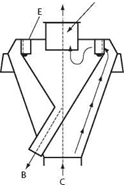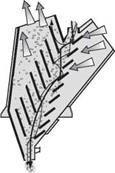An early invention was a static air separator in which there are no moving parts and classification occurs by changes in air velocity and direction. Figure 9.8 shows the method of operation of a cone-type separator. The air stream (C) carrying the particles is converted from a directional flow through the outer cone into a rotating flow by guide vanes (E). The particles are subject to centrifugal force; the coarse particles move to the outer wall of the inner cone and spiral down it to enter the reject stream (B); and the fine particles move into an upward spiral in the center of the cone and are carried away (A, D). As air velocity increases, centrifugal force increases and separation becomes more efficient. The product size can be altered to some extent by changing the angle of the vanes, but the efficiency is low, and static classifiers can be regarded more as grit separators than efficient classifiers.
The V-Separator is a static separator that was patented in Germany in 1993 and in the United States in 1996 (Sussegger and Strasser 1996). The HPGR product required deagglomeration before separation into fine and coarse particles; the V-Separator, shown in Figure 9.9, does both duties.
In this configuration, the feed is directed down through baffles to meet the rising airflow. The weak compacts are broken as they collide with the baffles, and the fine and coarse particles are liberated. The fine particles are entrained in the air and swept
|
Type |
d50, pm |
Bypass, % |
Sharpness |
|
|
Static |
0.25 |
Not applicable |
60+ |
0.65-0.75 |
|
First generation |
0.4 |
20+ |
50+ |
0.80-0.85 |
|
Second generation |
0.55 |
15-20 |
15-35 |
0.85-0.90 |
|
Third generation |
0.7 |
10-15 |
5-15 |
0.95-1.20 |
|
TABLE 9.1 Improvement in the performance of air separators for cement grinding circuits 18802000 |
|
Source: Oner 2002. |
 |
 |
FIGURE 9.8 Static air classifier FIGURE 9.9 V-Separator (Lee and Sussegger
1995; reprinted by permission from KHD Wedag)
upward through a further set of baffles with which they collide, and the coarser particles are knocked out of the stream and fall back into the rising air. They either leave with the main stream of coarse particles at the base of the separator or enter the fine product. The separation size is adjusted by changing the airflow rate.
Like the static cone separator, the V-Separator is inexpensive, has low energy consumption, and is reasonably efficient at coarser sizes. Its place in a closed grinding circuit was described in the U. S. patent, and Figure 9.10 shows the sketch included in that patent. Separator feed is fresh feed and HPGR product; reject is HPGR feed; and fines are classified twice before a final product is made. The classifier rejects are ground in a ball mill. The V-Separator is representative of the type of unit in which separation occurs by changing the direction of flow frequently, thereby causing coarser particles to drop out of the stream.
Several separators based on this principle have been built, such as the Alpine Zig Zag classifier shown in Figure 9.11. These are known as grit separators.
